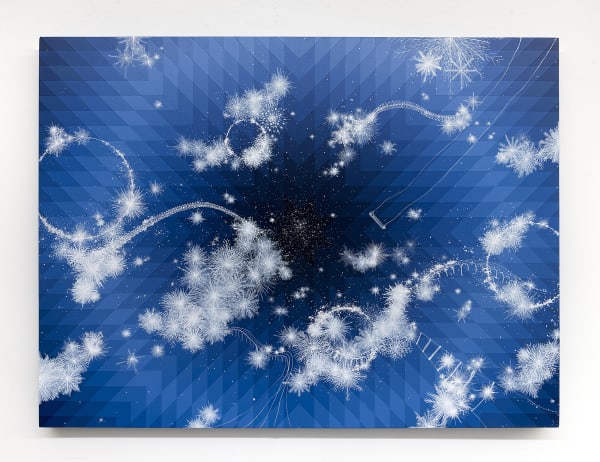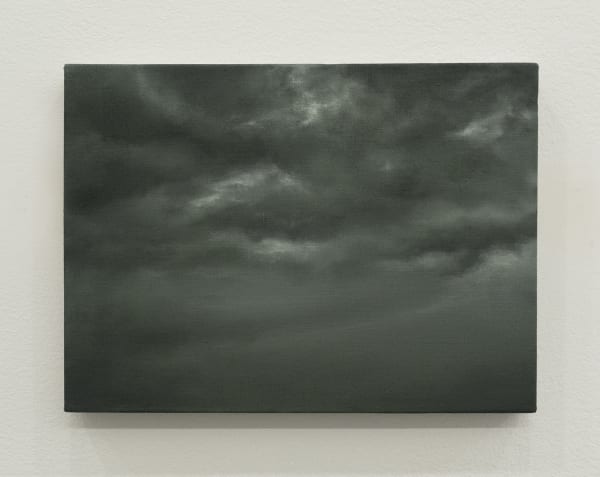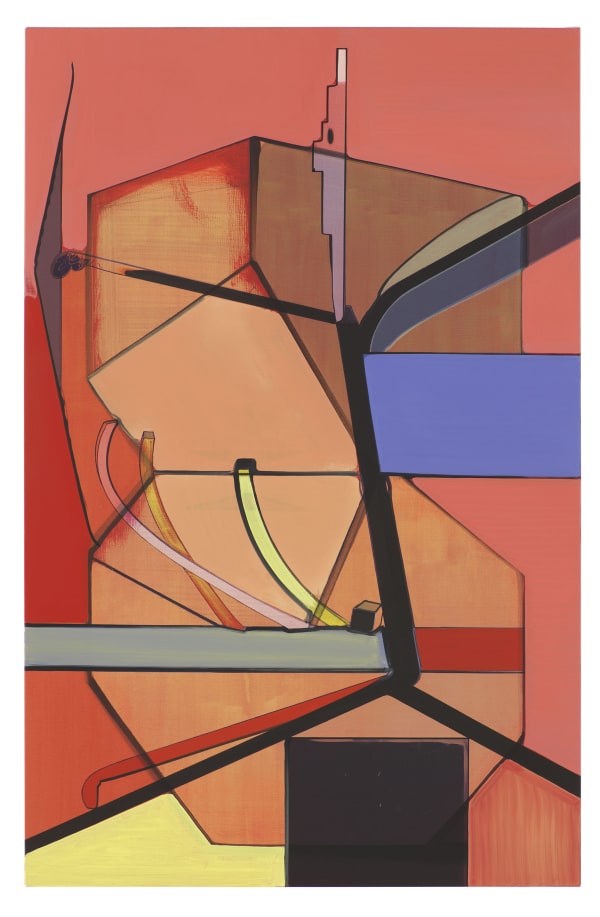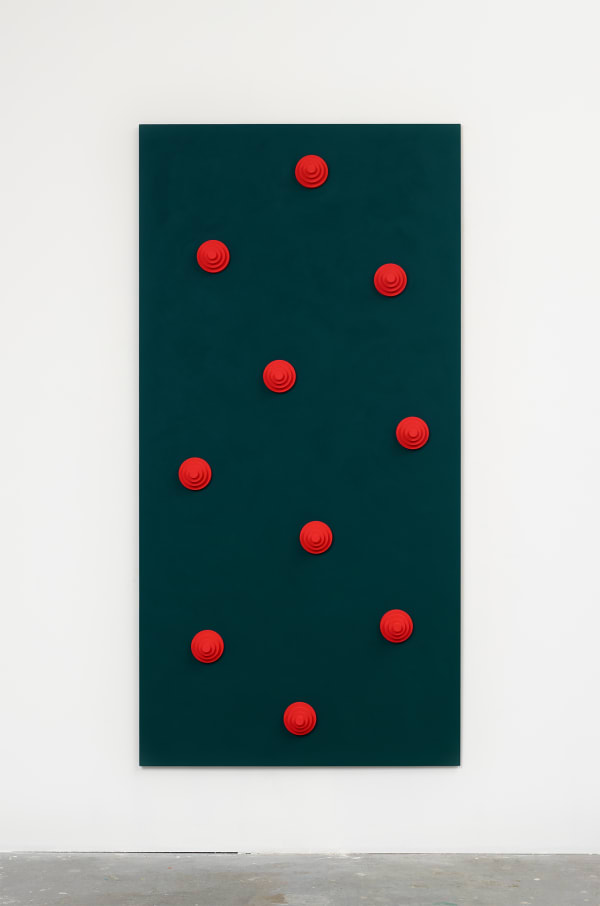
Material tactility, its possibilities, limitations, and transformation form the core of Kelly Akashi's practice. Originally trained in analog photography, traditional processes and the materiality of documents continue to inform and fuel her sculptural explorations. Working in a variety of media, such as wax, bronze, fire, glass, silicone, copper, and rope, Akashi investigates the capacity and boundaries of these elements and their ability to construct and challenge conventional concepts of form.
Kelly Akashi’s Be Me (Sounding) visualizes 'echolocating' or sounding through the spiraling glass cane pattern. Extending ideas from an earlier work, Triple Helix, the artist is exploring history and lineage. In this work, Akashi is thinking about her own ancestry and family history, considering the connections from a multi-cultural cross section.

Kelly AKASHI
Mood Organ
2020
Hand-blown glass, bronze
6 1/2 x 7 x 14 inches


Throughout her career, Sandra Cinto has developed a rich vocabulary of symbols and lines to create lyrical landscapes and narratives that hover between fantasy and reality. Using drawing as her point of departure, the artist renders intricate and mesmerizing environments of turbulent seascapes, violent rainstorms, and celestial skies that frequently engage with the surrounding architecture to a disorienting effect, creating the illusion of a weightless, spiraling universe. Evoking stories of human hardship and redemption, these fantastical landscapes serve as a metaphor for the human odyssey, while also pushing the limits and possibilities of drawing.

Sandra CINTO
Untitled
2020
Acrylic on canvas
29 1/2 x 39 3/8 x 1 1/8 inches; 75 x 100 x 3 cm

Djurberg and Berg’s collaborative works conjure surreal landscapes that explore the shadows of human subconsciousness. In One Last Trip to the Underworld (Blue and Orange), a whimsical bird sucks on a fantastical flower, sumptuous formations in vivid colors, bringing the artists’ animations to life and into real space.



A cluster of 235 crystal spheres, Sunflower worldview resembles the stamen and pistil of a sunflower or a circular mass of large water droplets. The spheres, whose backs are given a mirror finish through a hand-silvering process, are different sizes, their arrangement presenting no geometric logic.
The mirror finish covers only the back third of each sphere, over which a flat black paint has been applied. The wide angle of the mirroring allows each sphere to capture a view of the entire cluster. Taken together, the spheres present 235 curved reflections, each one encompassing not only the visitor, but also the entire mirrored-glass system that produces her reflections.

Olafur ELIASSON
Sunflower worldview
2020
Partially silvered crystal spheres, paint (black), stainless steel
51 1/4 x 51 1/4 x 6 1/8 inches; 130 x 130 x 15.6 cm

Olafur ELIASSON
Deescalating sun (critical zone)
2020
Watercolor and pencil on paper
Two parts; each 28 1/8 x 21 1/4 inches; 71.6 x 53.9 cm


Jonsi’s decades long practice as an interdisciplinary artist has often incorporated a physically and spiritually transcendent dimension. His wide ranging use of materials - from recordings of his own unique voice, to lighting systems to found objects, from hunting knives to sex toys - subverts standard utility and expectations to explore their potential for sensory stimulation and temporal narratives. In Ambertomb (Tears of the sun), 2020, Jonsi presents sculpture as artifact, relic, and powerful Talisman. A skeletal form is encased in glass resin as if in the midst of metamorphosis or hibernation. The encasement cycles through a sequence of three shades of amber light. The artist describes profound powers imbued into the Ambertomb, offering the artwork as symbol and metaphor for the fragility and complexity of body and mind.

Jónsi
Ambertomb (Tears of the sun)
2020
Glass dildos, steel buttplugs, resin, aluminum, acrylic, LEDs and electronics
18 1/2 x 23 1/2 x 14 1/2 inches; 47 x 59.7 x 36.8 cm


In her photography practice, Liu uses personal iPhone videos and Google image searches as primary sources for her work. By searching words and phrases online, Liu identifies images with multiple meanings that can be attributed to the same word, offering a diversity of perspectives and interpretations. In Liu Shiyuan's For Jord series, each intricate composition results from a carefully considered and emotionally driven logic. Embedded in each photograph are a variety of images, from animals and natural landscapes to references of the artificial. Each image builds on this idea of semiotic complexity, how each symbol garners new connotations in unusual contexts. She also incorporates video into her photographs by laying out the video stills frame by frame on the picture surface. Emphasizing the story told by individual images, which is often different than the original film, the viewer is able to scrutinize every transitory moment otherwise unnoticed in a continuous motion picture.

LIU Shiyuan
For Jord (No. 1)
2020
Giclee print face mounted to UV acrylic and back mounted on dibond in artist frame
51 1/8 x 61 1⁄2 x 1 1⁄2 inches; 129.8 x 156.2 x 3.8 cm
Edition of 5, 1 AP

LIU Shiyuan
Punished You and Me No.6
2019
Color marker pen and white oil based permanent marker on watercolor paper
41 7/8 x 30 1/8 x 1 1/2 inches; 106.4 x 76.5 x 3.8 cm (framed)


Since the mid-1990s Ernesto Neto has produced an influential body of work that explores constructions of social space and the natural world by inviting physical interaction and sensory experience. Drawing from Biomorphism and minimalist sculpture, along with Neo-concretism and other Brazilian vanguard movements of the 1960s & ‘70s, the artist both references and incorporates organic shapes and materials engaging all five senses and producing a new type of sensory perception that renegotiates boundaries between artwork and viewer, the organic and manmade, the natural, spiritual and social worlds.
This wall based crochet work by Ernesto Neto is part of a body of work in which the artist uses tension to dictate form. Here, a dynamic color pattern is conjured by the craft of hand-dying each thread and mixing the colors. This represents a fusion of cultures and the merging of life and nature into a more unified experience.
The slow, collective activity is precisely planned yet organic and on the verge of ritualistic, and demonstrates another powerful expression of Neto’s artistic practice.

Ernesto NETO
yosoy
2016
Cotton knit crochet, wooden hooks
126 x 156 x 1 3/8 inches; 320 x 396.2 x 3.5 cm

Ernesto NETO
while time goes by...enquanto o tempo passa
1996/2020
Photo series
63 x 74 7/8 inches; 160 x 190 cm (overall)
Edition of 5, 2AP

Karyn Olivier’s artistic practice merges multiple histories and collective memory with present-day narratives. After experiencing disparate losses: the pandemic, economic hardships, personal loss, dissipation of the loud cries for racial justice and our troubled democracy, the artist returned to a piece of found driftwood she had saved from five years ago. The gap in the wood became emblematic, literal and metaphorical to the complicated and fragmented world around us. Filling up this gap with clothing, this piece relates to Olivier’s long interest in working through ideas of human migration and immigration, mutability of objects, instability and present absences. The title, Stop gap becomes an attempt to create a solution to deal with our urgent problems and challenges.


Dana Powell's small-scale oil paintings depict moments of transition and anticipation. They take the shape of night drives, full moons, swimming pools, elevator doors, still lifes with fruit, explosions, and peep holes. Unrelated at first look, these subjects prove malleable apparatus in demonstrating the unsettling power of the ordinary, and emotive potential of small shifts in formal painting strategies. Considered austerity is applied to Powell’s tableaus of the everyday, offering a window to the familiar and its undertow.

Dana POWELL
Cloud cover
2020
Oil on linen
9 x 12 inches 22.9 x 30.5cm

Analia Saban dissects and reconfigures traditional notions of painting, often using the medium of paint as the subject itself. Throughout her career, Saban has utilized unconventional methods to explore the art-making process and blur the lines between painting and sculpture, imagery and objecthood. In this work, Saban explores fragility, balance, technique and experimentation of painting, drawing upon its possible functions and tapping into its historical linkages in order to push beyond its perceived boundaries.
In Pleated Ink (Music Synthesizer: Moog Modular, 1963), Saban replicates the buttons and nodes of a synthesizer, creating a laser cut pattern of the machine. After pouring a thick layer of ink onto the pattern, the negative space is filled with pools of ink covering the surface of the wood panel. Using elements and processes that have continued throughout her career - the precision of laser cut paper, ripples created by printers ink, the rigid and mechanical forms of machines - this work brings together essential components of Saban’s practice.

Analia Saban
Pleated Ink (Music Synthesizer: Moog Modular, 1963)
2020
Ink on panel
56 1/2 x 60 inches; 143.5 x 152.4 cm


Informed by the worlds of art, architecture, natural sciences and engineering, Tomás Saraceno’s floating sculptures and interactive installations propose new, sustainable ways of inhabiting the environment. Embodying one of the core concepts in Saraceno's work, 2M0045+16/M+M presents a model of life floating in space and suggests an architectural vision of the future. Suspended from the ceiling as if a luminous cloud or a collection of beautiful bubbles, the complex geometric shape of the modules are derived from the artist's continued experimentation with a structure termed the "Weaire-Phelan Model," which describes an idealized mathematical geometry of foam. The mesmerizing visual quality of the sculpture results from each mirrored panel’s reflected surroundings shifting as the viewer’s perspective changes.

Tomás SARACENO
2M0045+16/M+M
2019
Powder coated stainless steel, polyester rope, monofilament fishing line, metal wire, mirror panels
34 5/8 x 59 x 59 inches; 88 x 150 x 150 cm


Among the leading German artists of his generation, Thomas Scheibitz has developed his own conceptual language that bridges the realms of figuration and abstraction, at times dissolving them entirely. Drawing from classical painting and architecture, the contemporary urban landscape, and popular culture, Scheibitz deconstructs and recombines signs, images, shapes, and architectural fragments in ways that challenge traditional contexts and interpretations. While centrally concerned with principles of classification and systems of order, the artist’s paintings, sculptures and works on paper resist traditional categorization.
Donald and Palace have both been used as titles for previous works by the artist. Both motifs are composed here in a way that looks reminiscent of a double exposure. Of course an obvious link may be drawn to current day US politics, however this was coincidental. Donald and Palace is currently included in Thomas Scheibitz’s solo exhibition at Tanya Bonakdar Gallery, New York on view through December 18, 2020.

Thomas SCHEIBITZ
Donald and Palace
2020
Oil, vinyl and pigment marker on canvas
55 1/8 x 35 3/8 x 1 1/8 inches; 140 x 90 x 3 cm

Drawing from traditional sculptural aesthetics and the foundations of minimalism, Lisa Williamson’s practice uses formal qualities of color, materiality and form to create playful and essentialized abstractions. By carefully paring down forms inspired by the figure, architecture or everyday objects — such as swimming pools, barbells or stereos — Williamson brings a sense of joy and boldness to her highly associative works. Together, these objects create the characters of a language, developing and informing a dialogue with one another and the viewer. Often using the scale and proportions of her own body or the surrounding environment, Williamson creates a harmony of muted and electric hues in her work to convey reflections or bring attention to otherwise overlooked areas such as edges or internal cavities. In her Body Board series, the artist animates each human scaled object with its own personality, using shape and texture to embed character. Blurring the lines between painting and sculpture, landscape and portraiture, Williamson’s practice creates a dynamic narrative of physicality, volume and language.

Lisa Williamson
Body Board, Nerves
2016
Vinyl paint on powder-coated aluminum
80 x 40 x 2 1/2 inches; 203.2 x 101.6 x 6.4 cm